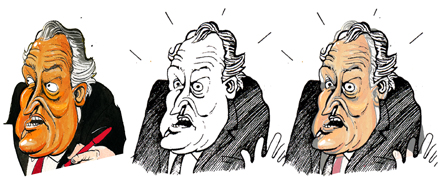Morten Morland wrote here:
"Influence, plagiarism, copying etc, is a difficult subject in any creative profession. It’s been said that plagiarism is the sincerest form of flattery, but I have a feeling it was a plagiarist who first said it. In court. On his knees. It’s bollocks of course. In its purest form it’s the sincerest form of laziness…
In a profession like cartooning though, it can often be difficult to distinguish between intentional plagiarism and (unfortunate) coincidence, and between influence and identity theft. I reckon most cartoonist at some point must have drawn a cartoon and realised afterwards that the idea was not a result of their own brilliance, but an unintentional ‘rip-off’ of an idea they’d seen in the past. As most cartoonists themselves are eager follower of cartoons, it is not entirely surprising that this can happen.
In order to avoid it, some cartoonists deliberately refrain from regularly looking at other cartoonists’ work. I personally stopped my almost daily trawl through Daryl Cagle’s website after it last happened to me a couple of years ago with a cartoon about the Iraq war. I didn’t realise the mistake until I saw my drawing in the paper the next day, and suddenly made the link to a cartoon I’d seen on the Cagle website a few days before.
It’s an honest mistake of course, but embarrassing nonetheless – even if you’re not ‘caught’. Of course, when it comes to ideas, references and metaphors, many of them are so commonly used that it is impossible to say whether the use of them stem from one cartoonist in particular, or if they simply are so ‘obvious’ that many would have picked them up anyway. This is regularly illustrated by the fact that several cartoonist do virtually identical ideas on the same day.
But what about more deliberate copying? Most cartoonists will at some stage in their career have looked someone else’s cartoons and caricatures and picked up elements that work particularly well, to use in their own drawings. Things like style, line, colour and composition. That kind of influence is mostly harmless – and a natural step in the progress of finding your own unique expression.
For the cartoonist being copied, it might indeed be flattering, as long as the line between flattery and identity theft is not crossed. When new politicians enters the scene, there’s a race between cartoonists to see who first ‘gets’ them. Particularly when it comes to party leaders. Take an example like Blair’s eyeball, which I think it’s been established that Steve Bell first coined, and which others, myself included, subsequently adopted some extent.
It’s natural, maybe unavoidable, that this sort of thing happens, but where does the line go? You could argue that the eyeball is a physical attribute which Steve first picked up on, but which everyone must be free to exploit. Or less you would end up in a situation where the first one to draw Gordon with big jowls had the ‘copyright’. A cartoon creation like Major’s pants, would be a more clear cut case, but Steve could be forgiven for thinking that the eyeball was a similar creation.
Run debate!He gave an update and afterthought:
An afterthought: I’ve been tipped off a couple of times by a friend of mine about an illustrator in Norway who seems to be tracing some of my characters for his own work. I haven’t got an example to hand, but anyway, they’re so crudely done that I haven’t felt the need to do anything about it. However to my surprise and slight amusement, I found a similarly blatant example of the sincerest form of laziness in a recent edition of Private Eye. A cartoonist, who I shall not name, has copied one of my caricatures of Peter Hain down to the details of the number of wrinkles on his forehead.
It’s an extreme example of course, which hopefully, for this particular individual’s sake, is a one-off. Still, considering what I’ve said above, I defy any cartoonist to throw the first stone."



No comments:
Post a Comment